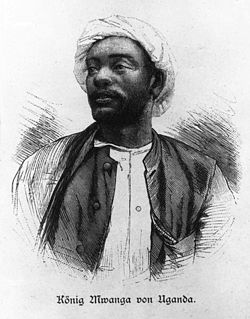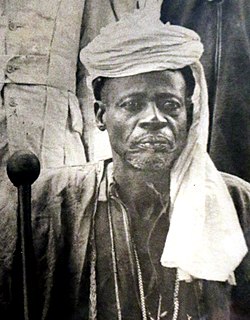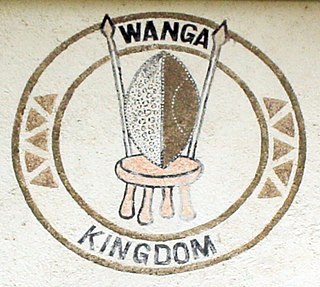Related Research Articles

The Luhya are a group of 19 distinct Bantu tribes in Kenya that lack a common origin and were politically united in the mid 20th century. They number 6,823,842 people according to the 2019 census, being about 14.35% of Kenya's total population of 47.6 million, and are the second-largest ethnic group in Kenya.

Danieri Basammula-Ekkere Mwanga II Mukasa was Kabaka of Buganda from 1884 until 1888 and from 1889 until 1897. He was the 31st Kabaka of Buganda.

Kabaka is the title of the king of the Kingdom of Buganda. According to the traditions of the Baganda they are ruled by two kings, one spiritual and the other secular.
Matungu is a small town in the Western Province of Kenya. It is located in the Kakamega County.

Mumias is a town in Kakamega County of Kenya. The town has an urban population of 116,358 . Mumias was the center of the Mumias District. The town is linked by road to Kakamega, Busia (west), Bungoma (north), Butere (south). The village of Buchinga is located between Mumias and Kakamega.
City High School is a private secondary school in Nairobi, Kenya.

The Wanga(AbaWanga) are a tribe of the Luhya people of Kenya. They mainly occupy Butere-Mumias in Kakamega County of Kenya's old Western Province.

The Maragoli, or Logoli (Ava-Logooli), are now the second-largest ethnic group of the 6 million-strong Luhya nation in Kenya, numbering around 2.1 million, or 15% of the Luhya people according to the last Kenyan census. Their language is called "Logoli", "Lulogooli", "Ululogooli", or "Maragoli". The name "Maragoli" probably emerged later on after interaction of the people with missionaries of the Quaker Church.
Mwanga I Sebanakitta was Kabaka of the Kingdom of Buganda from 1740 until 1741. He was the twenty third (23rd) Kabaka of Buganda.
Ndawula Nsobya was Kabaka of the Kingdom of Buganda between 1724 and 1734. He was the nineteenth (19th) Kabaka of Buganda.
Mawanda Sebanakitta was Kabaka (King) of the Kingdom of Buganda, between 1738 and 1740. He was the twenty second (22nd) Kabaka of Buganda.

Koyonzo is a settlement in Kenya's Western Province, Kakamega county. It was initially known as Mamboleo due to its early exposure to the long distance traders from the Mombasa to Buganda Kingdom. Koyonzo was in the Wanga Kingdom which was led by Nabongo Mumia. It is currently located along Mumias-Busia Road, a gateway to Uganda. The town is surrounded by the villages of Ngairwe, Munanziri, Mung'ungu, Mwira, Mirere, Matungu, Ejinja and Lunganyiro. The area boasts of famous persons such as Mwl. Dennis Nangabo from Ngairwe, Hon. David Were- Matungu M.P, Mr Kubende, MCA and the OMukenya family of Ngairwe.
The Kabras, or Kabarasi, are a subtribe of the Luhya people of Kenya. They reside in Malava that is in the Kabras Division of Kakamega District, which is neighboured by the Isukha, Banyala, Tsotso, and the Tachoni. The exact origin of the Luhya people is currently disputed, but there are historians who believe that the group came from Central and West Africa and migrated to their present-day location by way of the so-called Great Bantu Migration.

The Marama, also known as Abamarama, are a Luhya tribe occupying Marama Location in Kakamega District of the western province of Kenya. The town of Butere is located in west Marama and is a significant trading centre in Kakamega.

The Ganda people, or Baganda, are a Bantu ethnic group native to Buganda, a subnational kingdom within Uganda. Traditionally composed of 52 clans, the Baganda are the largest ethnic group in Uganda, comprising 16.5 percent of the population at the time of the 2014 census.

Nabongo Mumia Shiundu was a prince who became 17th King of the Wanga Kingdom, a pre-colonial kingdom in Kenya prominent for being a centralised, highly organised kingdom and the most advanced form of government in terms of politics, economy and military in pre-colonial Kenya. He later became paramount chief of an expansive region of Kenya at the beginning of British imposition of colonial rule in East Africa.

The Wanga kingdom is a Kenyan Bantu kingdom, consisting of the Wanga tribe of the Luhya people. The Wanga kingdom was the most organized structure of government in pre-colonial Kenya politically, economically, and militarily.

The Nabongo Cultural Centre and Shrine is a shrine and cultural centre dedicated to the Wanga Kingdom of the Luhya people in Kenya. The shrine contains the tombs of Wanga kings or Nabongo are buried, including the founder of Mumias, Nabongo Mumia. Locally known as Eshiembekho, the shrine is managed by the Luhya Council of Elders.
Wabala was a Nabongo (King) who ruled the Abawanga around 1140 - 1190. His father was called Wanga, the founding father of the famous Wanga Kingom. It is said that Nabongo Wanga had several sons among them: Murono, Muniafu, Wabala, Namagwa and Mutende and that when his death came there arose a succession dispute between his sons. Wanga had appointed Wabala as his successor over his elder brother, Murono. In the course of all the dispute, Wabala was assassinated in Bukhayo, so it was alleged that Murono was the one who instigated his brother's murder. Murono therefore arose to power at Matungu and enjoyed a short period of rein as the Nabongo. Later on, Wabala's son called Musui embattled Murono in which the latter won. Murono felt so defeated and rejected, there he went across River Nzoia and established another centre at Indangalasia.
References
- 1 2 "King Mumia's plan to reclaim past glory of Wanga Kingdom". nation.africa/kenya/news. Retrieved April 16, 2021.
- ↑ "The AbaWanga Kingdom: History, Present and Future". abawanga.wordpress.com. Retrieved April 16, 2021.
- 1 2 3 Oyoolo, Zadock Mukuyia (2017). Templates of Wanga Socio-Cultural Family Values in Thematic and Stylistic Analysis of Ali Akeko’s Selected Popular Songs. Nairobi: University of Nairobi. p. 3.
- 1 2 Murunga, Godwin Rapando (1998). The evolution of Mumias settlement into an urban centre to circa 1940. France: HAL archives-ouvertes. pp. 40–41.